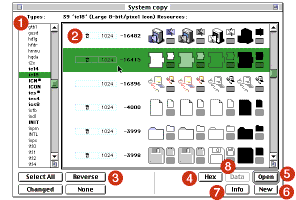Advocacy
Dojo (HowTo)
Reference
Markets
Museum
News
Other
![]()
Myths
Press
General
Hack
Hardware
Interface
Software
Standards
People
Forensics
Web
CodeNames
Easter Eggs
History
Innovation
Sightings
Opinion
Martial Arts
ITIL
Thought

![]()
|
The Basics of Resorcerer
Open a copy of your System, and you should see the following screen.

![]() The Type list shows a list of all the the resource types
available to edit in your open file. The ones in bold come
with custom editors that make it easier to hack when the
resource is selected.
The Type list shows a list of all the the resource types
available to edit in your open file. The ones in bold come
with custom editors that make it easier to hack when the
resource is selected.
![]() The
Resource list shows all the resources of the selected type
that can be opened and edited for that particular file. To
help you see what's what, the Resources List usually tries
to show you graphic representations of the resource data.
For MENUs, it shows the start of the menu; for icon
families, it draws the images of all the icons in one place;
for STRs, you see the actual text.
The
Resource list shows all the resources of the selected type
that can be opened and edited for that particular file. To
help you see what's what, the Resources List usually tries
to show you graphic representations of the resource data.
For MENUs, it shows the start of the menu; for icon
families, it draws the images of all the icons in one place;
for STRs, you see the actual text.
![]() Reverse
selects everything except what was selected. The Changed
button selects anything that you've worked on but haven't
yet saved.
Reverse
selects everything except what was selected. The Changed
button selects anything that you've worked on but haven't
yet saved.
![]() The
Hex button opens a hex editor that lets you get at a
resource's raw byte data. Hacking hexadecimal is always the
least pleasant option. You can edit any resource data as
hex, but you usually don't want to, because it's hard to
tell what the data's for.
The
Hex button opens a hex editor that lets you get at a
resource's raw byte data. Hacking hexadecimal is always the
least pleasant option. You can edit any resource data as
hex, but you usually don't want to, because it's hard to
tell what the data's for.
![]() The
Open button opens a resource's data for editing using the
best method it can. It also opens any special-purpose
editors that apply to the resource. If it can't find a
dedicated editor, the Open button acts like the Data button.
And if the proper data structure isn't known, the Open
button acts like the Hex button. You can open a file the
usual way with the Open File command, or you can use
Resorcerer's way-cool File System Browser to search for and
open any file (including invisible ones); just double-click
on any file to peek inside.
The
Open button opens a resource's data for editing using the
best method it can. It also opens any special-purpose
editors that apply to the resource. If it can't find a
dedicated editor, the Open button acts like the Data button.
And if the proper data structure isn't known, the Open
button acts like the Hex button. You can open a file the
usual way with the Open File command, or you can use
Resorcerer's way-cool File System Browser to search for and
open any file (including invisible ones); just double-click
on any file to peek inside.
![]() Selecting
New creates a new resource of the type selected. Most casual
hackers won't need to create resources from scratch.
Selecting
New creates a new resource of the type selected. Most casual
hackers won't need to create resources from scratch.
![]() The
Info button allows you to set a resource's attributes --
info such as ID numbers, names, and loading specifications.
You shouldn't hack resource attributes unless you really
know what you're doing or you risk harming your system.
The
Info button allows you to set a resource's attributes --
info such as ID numbers, names, and loading specifications.
You shouldn't hack resource attributes unless you really
know what you're doing or you risk harming your system.
![]() The
Data button opens your resource using a special data editor
that shows you the data structures the programmers used to
describe and build the resource. This is a long list of
numbers, strings, colors, and other stuff, all packed
together.
The
Data button opens your resource using a special data editor
that shows you the data structures the programmers used to
describe and build the resource. This is a long list of
numbers, strings, colors, and other stuff, all packed
together.
|